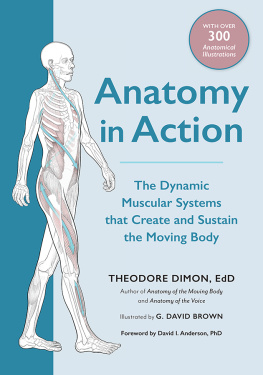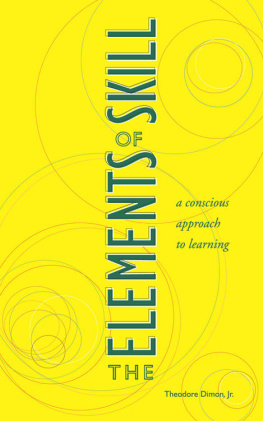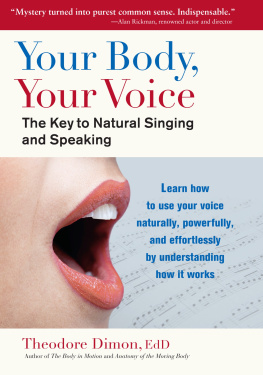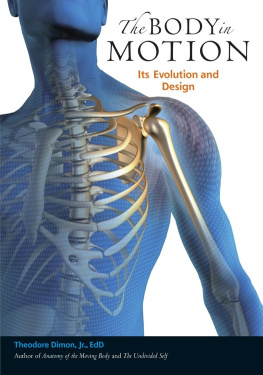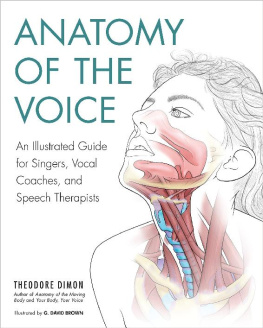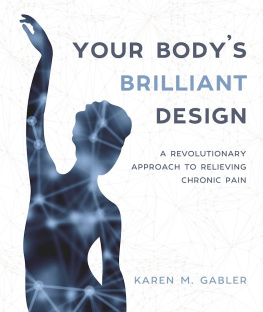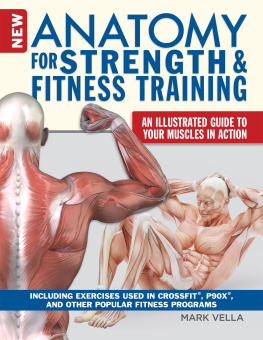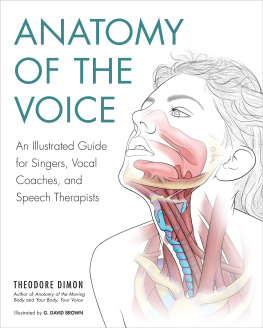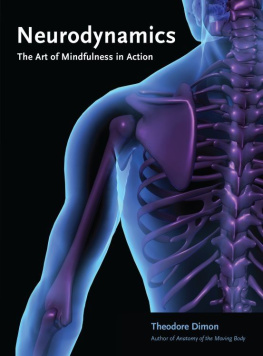
Copyright 2021 by Theodore Dimon. All rights reserved. No portion of this book, except for brief review, may be reproduced, stored in a retrieval system, or transmitted in any form or by any meanselectronic, mechanical, photocopying, recording, or otherwisewithout the written permission of the publisher. For information contact North Atlantic Books.
Published by
North Atlantic Books
Berkeley, California
Cover art and illustrations by G. David Brown
Cover design by G. David Brown and Jasmine Hromjak
Book design by Happenstance Type-O-Rama
Anatomy in Action: The Dynamic Muscular Systems that Create and Sustain the Moving Body is sponsored and published by North Atlantic Books, an educational nonprofit based in Berkeley, California, that collaborates with partners to develop cross-cultural perspectives; nurture holistic views of art, science, the humanities, and healing; and seed personal and global transformation by publishing work on the relationship of body, spirit, and nature.
North Atlantic Books publications are distributed to the US trade and internationally by Penguin Random House Publishers Services. For further information, visit our website at www.northatlanticbooks.com.
MEDICAL DISCLAIMER: The following information is intended for general information purposes only. Individuals should always see their health care provider before administering any suggestions made in this book. Any application of the material set forth in the following pages is at the readers discretion and is their sole responsibility.
Adapted chapter from Neurodynamics: The Art of Mindfulness in Action by Theodore Dimon, Jr., published by North Atlantic Books, copyright 2015 by Theodore Dimon, Jr. Reprinted by permission of the publisher.
Library of Congress Cataloging-in-Publication Data
Names: Dimon, Theodore, Jr. author.
Title: Anatomy in action : the dynamic muscular systems that create and
sustain the moving body / by Theodore Dimon.
Description: Berkeley, California : North Atlantic Books, [2021] | Includes
bibliographical references and index. | Summary: A guidebook
illustrating the principles behind the bodys musculoskeletal system
Provided by publisher.
Identifiers: LCCN 2020036965 (print) | LCCN 2020036966 (ebook) | ISBN
9781623175801 (trade paperback) | ISBN 9781623175818 (ebook)
Subjects: LCSH: Musculoskeletal systemAnatomy. | Human locomotion.
Classification: LCC QM100 .D558 2021 (print) | LCC QM100 (ebook) | DDC
612.7/6dc23
LC record available at https://lccn.loc.gov/2020036965
LC ebook record available at https://lccn.loc.gov/2020036966
Foreword
I have admired Ted Dimons work since I read one of his earliest books, The Elements of Skill: A Conscious Approach to Learning, many years ago. My admiration and enthusiasm for his work only increased after I read this latest book. The book is an important contribution to the literature and it has the potential to positively impact the field of human movement science as much as the profession of Alexander Technique teaching. Moreover, it offers a practical self-help guide to the countless numbers of people who seek a means for dealing with the myriad of maladies that result from chronic stress and tension.
I write this foreword several months after the start of the COVID-19 pandemic. The human species has experienced multiple pandemics over millennia, but one is particularly relevant to the subject matter of this book. It is the pandemic of musculoskeletal ailments that besets modern humans; a pandemic that may have started when our ancestors transitioned from hunter gatherers to farmers some twelve thousand years ago, but which was certainly exacerbated and accelerated by the start of the industrial revolution just over 250 years ago. F. M. Alexander argued convincingly that modern civilization was responsible for much of the physical deterioration observable in modern humans. Through systematic self-observation and experimentation, he developed a technique to address this deterioration. As proponents of the technique know, it is a reeducational technique rather than a therapeutic technique, treatment, or cure. It rests on the premise that specific problems in the musculoskeletal system can be understood and addressed only in the context of how the system operates as a functional whole. It stresses the importance of the dynamic relations among the parts of the system, not the least of which is the dynamic relation between the head, neck, and back in determining the integrated functioning of the whole system.
Alexander taught us that a generalized expansion of the musculoskeletal system characterizes effective and efficient movements. Such expansion is particularly apparent in a lengthening and widening of the torso and in the forward and upward movement of the head relative to the spine. He did not, however, have an anatomical or physiological explanation for why lengthening and widening was so fundamental to movements, though he was masterful in bringing about such lengthening and widening in his pupils. This is where Ted Dimon makes his primary contribution. He advances a theory of how the musculoskeletal system works that not only clarifies many of the teaching procedures in the Alexander Technique, but also challenges scientists to think about human movement in a new light. The theory builds on the principles of systematic self-observation and experimentation advocated by Alexander and draws on decades of experience teaching the Alexander Technique as well as recent scientific advances in our understanding of human biology.
Contemporary anatomy books provide detailed descriptions of bones, articulations, ligaments, and muscles in a mechanistic and reductionist manner. Yet they fail to explain how the entire collection of components that make up the musculoskeletal system has evolved to function as a coherent whole. These books privilege understanding the parts over understanding the whole, perhaps because we have such a poor understanding of what binds the parts into the whole. Anatomy in Action takes a very different approach. Ted Dimon contends that the musculo-skeletal system can be understood only in the context of its function to provide upright support. That support is not simply supplied by the bones, as is often taught to students of anatomy, but instead is a function of the dynamical relations between all of the components that comprise the musculoskeletal system, including bones, muscles, and the entire network of connective tissue. Counterintuitively, Ted Dimon argues that a critical contribution to the integrity and stability of the system, as well as to heightened proprioceptive awareness, is the muscles capacity to lengthen between their bony attachments. When the system functions the way it evolved to function, movements are light and effortless. When we interfere with that natural functioning, problems arise. These ideas are sure to cause a buzz in the scientific community and cause many to rethink the merits of the traditional and contemporary corrective exercise approaches to improving musculoskeletal functioning and human performance.
A lucid description of how the parts of the musculoskeletal system relate to the whole and how the whole in turn affects the parts is not the only contribution Anatomy in Action makes to our understanding of human movement. Equally important are the clear and concise step-by-step procedures for restoring the integration between the parts and the whole. The rationale behind the procedures, many of which will be familiar to teachers of the Alexander Technique, becomes obvious when viewed in the context of the theory of musculoskeletal functioning advanced in this book. Moreover, the procedures reveal it is possible to treat the root causes underlying musculoskeletal system dysfunction rather than just the symptoms associated with such dysfunction.
Next page
